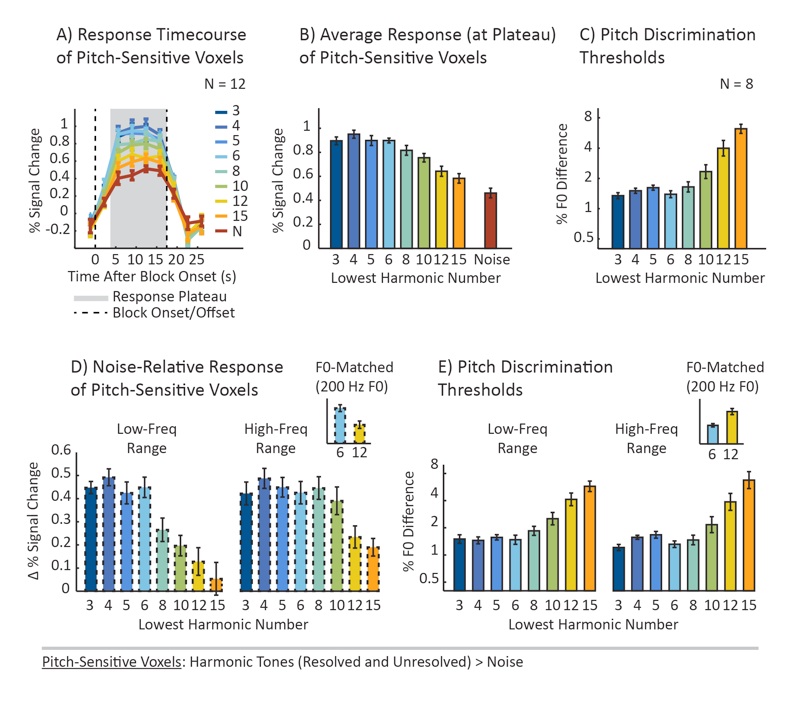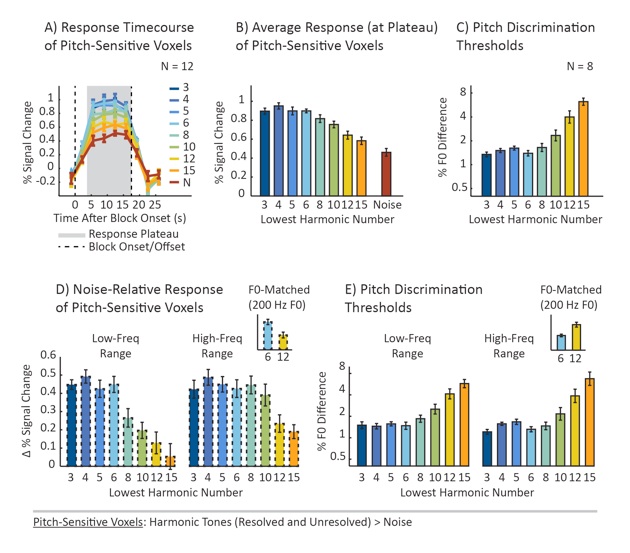
ROI Analysis of Pitch-Sensitive Voxels: Functional regions rarely occur in exactly the same anatomical position across subjects. We therefore identified pitch-sensitive voxels functionally, by searching for voxels that respond more to harmonic tones than noise (irrespective of resolvability). Using independent data, we then measured the response of these “localized” voxels to each harmonic and noise condition.
-
(A) The signal-averaged timecourse of pitch-sensitive voxels to each harmonic and noise condition, collapsing across the two frequency ranges tested. The numeric labels for each harmonic condition denote the number of the lowest harmonic for that condition (see Figure 2A for reference). Due to the hemodynamic lag, response timecourses contained a plateau (gray area), starting ~5 seconds after block onset.
-
(B) The average response across all time-points in the response plateau. Pitch-sensitive voxels responded substantially more to low-numbered, resolved harmonics compared with high-numbered, unresolved harmonics, suggesting that spectral pitch cues are the primary driver of the cortical pitch response. Responses to unresolved harmonic were nonetheless significantly higher than to noise, even for the mostly poorly resolved condition, consistent with a (weak) response to temporal pitch cues1.
-
(C) Pitch discrimination thresholds, measured behaviorally for the same stimuli, were highly correlated with the neural response (r = 0.96). Neural responses were high and discrimination thresholds low (indicating good performance) for harmonics up to the 8th. Above the 8th harmonic, neural responses and behavioral performance declined monotonically.
-
(D) The mean response difference between each harmonic condition and its frequency-matched noise control condition plotted separately for each frequency range tested. The inset highlights two conditions that were matched in average F0 (both 200 Hz) but differed maximally in resolvability: a low-frequency condition with low-numbered resolved harmonics (left bar, blue) and a high-frequency condition with high-numbered unresolved harmonics (right bar, yellow). For both frequency-ranges, low-numbered harmonics produced a larger response, and conditions with the same F0, produced a larger response when resolved.
-
(E) Pitch discrimination thresholds for each frequency range were again well-correlated with the neural response (r = 0.95 and 0.94 for the low- and high-frequency conditions respectively).
1Patterson RD, Uppenkamp S, Johnsrude IS, Griffiths TD (2002) The processing of temporal pitch and melody information in auditory cortex. Neuron.

